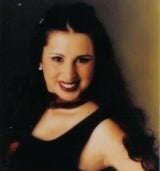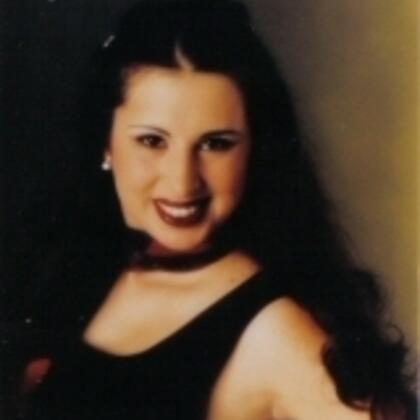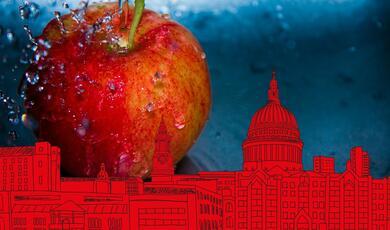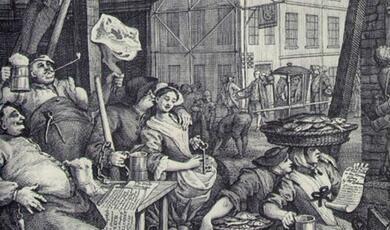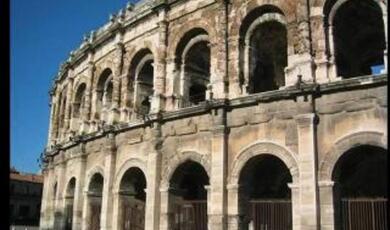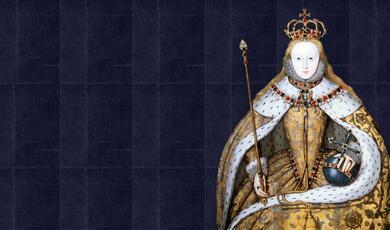Shattering Myths About Freemasonry
Share
- Details
- Text
- Audio
- Downloads
- Extra Reading
Freemasonry is a relatively obscure subject with many myths surrounding the organization. This lecture attempts to provide some insight into the past and present background of freemasonry as a fraternal organization, highlight the main myths associated with freemasonry as well as to shatter these myths or illusions hovering over its membership.
Download Text
by Pauline Chakmakjian
Freemasonry is a relatively obscure subject with many myths surrounding the organization. The purpose of this lecture this evening will be to provide you with some insight into the past and present background of freemasonry as a fraternal organization, highlight the main myths associated with freemasonry as well as to shatter these myths or illusions hovering over its membership. I hope you will walk away with an increased knowledge of some important factual details about freemasonry so that it does not strike you as such a daunting and mysterious topic.
The precise origin of freemasonry is unknown, so we only have certain theories put forward with respect to how, where, and why it started. I do not have time to explain all the theories that exist at present, but the theory I agree with is that freemasonry ' as we know it today ' arose as a new type of salon society with a strong esoteric aspect. This happened when a few English middle and upper-class gentlemen and intellectuals borrowed certain traditions from the medieval guild of stonemasons and consolidated their own societal headquarters in London in 1717.
Origins of freemasonry in Britain
In medieval times, there were all different kinds of guilds specific to every trade or artisan craft, e.g. a guild for pewterers, butchers, glovers, saddlers, etc. There were literally dozens of them, and they are still extant in the City of London today. In Europe, among these many guilds was of course also the guild of stonemasons, who were artisans responsible for the construction of complex structures like castles and cathedrals. In masonic scholarship, the guild of masons trained in the actual craft of stonemasonry is referred to as operative freemasonry.
Within the guild system, the skills of any one craft were transmitted through a hierarchical apprenticeship system and oral tradition. Therefore, becoming a stonemason involved both an initiation process and swearing to secrecy of the trade skills learned. In other words, just as we have passwords to access websites and swipe cards to enter buildings today, so too did the stonemasons have passwords to identify whether someone was a member of their guild and their rank, i.e. whether they were an apprentice or master mason (the most highly skilled stonemason).
Towards the end of the seventeenth century, the guild system started to die out; and England experienced the rise of coffee-house culture. As P Clark states in British Clubs and Societies (Oxford, 2000):
The great surge of public sociability at inns and alehouses began in the late seventeenth century when innkeepers and publicans became leaders in sponsoring new kinds of fashionable entertainment, from concerts to cricket and clubs. The first coffee-house opened in Oxford in the 1650s and others quickly followed; they were places to discuss politics, plays, or foreign news.
What we find here is something very different from feudalism. Feudalism was a very efficient system in which everyone knew their place. With this shift to coffee-house culture, what we see is that instead of history simply occurring while people lived out their lives unconscious of their world, more people are starting to be more aware of their surroundings, aware of their society, and start to discuss their opinions about a variety of subjects. For the first time there was a notion of genuine happiness through people choosing what they wanted to talk about and being free to express their opinions openly in contrast to rigid feudalism. This is also considered by many scholars to be a period known in intellectual history as pre-Enlightenment. There is no one definition of the Enlightenment, but broadly speaking it was a combination of scientific advancement, increased sociability, and a greater consciousness of living and participation in society through meeting places. It is questionable if Britain experienced an Enlightenment, but Clark states, 'If a British enlightenment did exist, then one of its principal engines was the Georgian voluntary society.'
Emergence of 'speculative' freemasons
George I started his reign in 1714, and he set a trend for frequent socializing between 1717 and 1720. It is important to note three phenomena at this point: first, relaxed social interaction amongst the nobility, gentry, and commoners; second, inns and taverns being used as meeting places; and finally, that geometry and architecture were considered particularly fashionable topics of study among the educated middle- and upper-class male gentry and aristocracy. When we consider all these elements together at this time in English society, it is not altogether that surprising that something like speculative freemasonry emerged in 1717 London. In masonic scholarship, speculative freemasonry is the expression used to refer to those men who borrowed certain traditions from the operative stonemasons to form a fraternity.
Operative stonemasons travelled for their work - the job did not come to the stonemason, the stonemason went to the building site. As they travelled, they would be lodgers and this later developed into the guild system in which networks of operative lodges grew (the system in Scotland being particularly advanced). The meeting place of the speculative freemasons was an inn or tavern, but they too were called lodges. The first four speculative lodges documented as having come together to form the first Grand Lodge of England in 1717 were situated near St. Paul's: The Goose and the Gridiron, The Apple Tree, The Crown, and The Rummer and Grapes. After their union to form the Grand Lodge, little by little an entire network of lodges throughout London and the provinces started to form.
The primary objective of these lodges was to unite men of different religious faiths (and one had to have a faith in order to join), and to encourage friendship among such men. There is a misconception that freemasons worship a composite and/or pagan god; but in reality the religious aspect in freemasonry consists of how each individual freemason sees God, e.g. Yahweh to the Jew, Christ to the Christian, Allah to the Muslim. One of the rules of membership was - and still is - that no discussion of religion or politics is allowed in the lodges as these are the two things that divide people the most. These and other regulations are found in the constitutions of each Grand Lodge. Although the focus of Masonic lodges today has moved more towards greater charitable works and social gatherings, the freemasonry of eighteenth-century England was more akin to a cultural salon with respect to the majority of its activities. In the assessment of M Jacob in Living the Enlightenment (Oxford, 1991):
The underlying themes of Masonic literature were improvement and enlightenment, with a stress on merit as the measure of men, education, and the joys of fraternal association; in sum, a utopian world detached from political, religious, or ascribed social status. These themes appear elsewhere in the associational literature of the eighteenth century, but Freemasons articulated them more consistently and loudly . . . There is considerable evidence, at least for the early eighteenth century, that Masons were actively involved in 'mental improvement' . . . A Masonic tract in 1729 spoke of 'most lodges in London and several other parts of this kingdom [having] a lecture on some point of geometry and architecture.' Such activities were not confined to obvious Masonic themes. During the 1730s, the Old King's Arms lodge in London heard lectures ranging over military architecture, the circulation of blood, optics, the structure of muscles, and the chemical process of fermentation.
There were hundreds of clubs in London throughout the eighteenth century all competing for members to increase their memberships. Freemasonry was one of the most successful not only because of its vast network of London and Provincial lodges, but also because it successfully marketed its society using the patronage of nobles and royals. This tradition continues to this day with HRH The Duke of Kent as the current Grand Master of the United Grand Lodge of England.
MYTH #1: Freemasonry is a Religion
Freemasonry is not a religion because it lacks the fundamental elements of a religion. It offers no sacraments or salvation, it has no one enlightened founder and it has no sacred text of its own. However, it is a quasi-religious organization since prayers are said, an organ is usually played, and - most significantly - in order to become freemasons within the jurisdiction of the United Grand Lodge of England, candidates must believe in a Supreme Being, who is referred to as The Great Architect Of The Universe (TGAOTU). The TGAOTU is, again, not a composite or a pagan god, but how each freemason interprets God. It is a symbolic representation of the ideal one aspires of oneself following the example of the Supreme Being of one's personal faith: i.e., it is a state of perfection that the freemason is attempting to emulate and come as near to as possible. Moreover, freemasonry is striving for mental, spiritual, and moral improvement of the self through ritual and contemplation as well as improvement of society through charitable works. Masonic society, according to G di Bernardo in Freemasonry and Its Image of Man (Freestone, 1989), 'does not possess a wider truth, of which the truth of the single religions are partial manifestations. Freemasonry regards all particular religions as having equal dignity.' Therefore, freemasonry is closer to concepts like freedom of religion and tolerance; it was specifically constructed to be an enhancer of religion as well as a public sphere of introspective and esoteric study for its members.
As some of you may already know, masonic buildings of speculative freemasons can be easily identified by the symbol of the letter G surrounded by a square and compasses. In medieval times when operative stonemasons carried out their traditions, 'G' represented the Christian Godhead. In 1723, speculative freemasonry drafted its firstConstitutions containing a fictional history, the Charges and Regulations (Laws) of freemasonry, and a collection of songs. The first Charge in the 1723 edition seems to maintain a centre on Christianity as the basis for 'G' while allowing Christians of all denominations within that faith alone to become freemasons. This was an apparent attempt to ensure no Catholic-Protestant divide occurred amongst the membership. Some might argue that this first Charge implied a plea for deism, but this is a difficult argument as there was no precise definition of whom a deist would or would not be. It is important to note that deism covered a variety of overlapping ideas and beliefs ranging from liberal Christianity to atheism.
The Constitutions changed over time during which many editions refined and altered the Charges. The Grand Lodges of England, Scotland, and Ireland were and still are in agreement on the most fundamental aspects of masonic theory and practice. With respect to the first Charge and membership requirement, in 1815 the United Grand Lodge of England sanctioned a more liberal and inclusive definition of TGAOTU. As a result, lodges within British freemasonry are not only capable of accepting Christian candidates (regardless of denomination) but also Jews, Muslims, Hindus, etc. (regardless of religion). These religions profess ontological belief in a Supreme Being, allowing the chief initiation requirement to be met in a fairly straightforward manner. This becomes slightly more complicated amongst the Eastern belief systems such as Buddhism and Shinto. Incidentally, I am at present a Doctoral candidate with the University of Wales, Lampeter and am researching this very issue with freemasonry in Japan in association with Japanese sociability being the focus of my thesis. However, let me now move on to the second myth.
MYTH #2: Freemasonry is a Secret Society
Freemasonry is often described as not a secret society, but a society with secrets. The building of the Freemasons' Hall, which most of you have just been given a tour of allows any member of the public to use its library, peruse its archives and question its ever attentive and knowledgeable staff of mostly non-masons about freemasonry. The Hall also contains within its premises a Gift Shop where masons and non-masons can purchase books about masonic history, symbolism and even the various ritual books used in their catechistic rituals know as degrees, Emulation Ritual being the most popular for the Craft (first three degrees) of Entered Apprentice, Fellow Craft and Master Mason. These ritual books contain abbreviated words, which can easily be deciphered using an exposure publication like Walton Hannah's Darkness Visible. Additionally, anyone with a reader's ticket for the British Library can have access to all the masonic rituals, word for word, motion for motion.
If freemasonry were a genuine secret society, one would likely not even be aware of its existence. What we have here instead is a situation whereby the headquarters of this organization allows members of the general public to walk about its premises during regular hours and special open days and to use its resources, including the rental of the building itself. In terms of its membership, freemasonry has the right to include or exclude whomever it pleases since, apart from its own unique characteristics as an organization, it is essentially no different from any other club or society, all of whom have the custom of keeping their membership lists as well as their activities for the enjoyment of their members only. Moreover, generally speaking, most masons will be happy to reveal their membership, but would not feel comfortable with having to be forced to do so by any legislation.
The heart at the idea of the secret or secrecy within freemasonry is closely linked to the religious, spiritual and esoteric nature of its rituals. Just as someone who has experienced an epiphany, conversion, enlightenment or baptism in conjunction with the spiritual side of ones self, it is a mystery or secret known only to himself what every freemason is intended to experience during each of the rituals as he passes from one degree to the next. The degree rituals are basically opportunities for freemasons to express their notions of particular concepts like faith, humility, death, etc. through a combination of drama, mime, gesture, symbolism and allegory.
MYTH #3: Freemasonry is Involved in Some International Conspiracy
Officially, there is no international governing body of freemasonry. While the United Grand Lodge of England is considered to be the 'Mother' Grand Lodge of the World, this conveys the idea that other countries in which freemasonry exists looks to England as a model for their own masonic practices rather than England being a controlling force or there being a group composed of high-ranking masons somewhere who dictate a plan for world domination to the lower orders.
I am going to intertwine this section of my talk with some of the terminology surrounding freemasonry in addition to explaining its formal structure. The basic unit of freemasonry is the lodge with its leader being the Master of the lodge. It follows then that the administrative and ceremonial headquarters of a particular type of freemasonry practiced by a country or American state is known as the Grand Lodge with its leader being the Grand Master. The first recorded Grand Lodge of London in 1717 was known as both the Moderns Grand Lodge of England and the Premier Grand Lodge. There then arose a feud between two main groupings of freemasons. In 1751, a rival grand lodge known as the Antients Grand Lodge formed as a result of increased exclusivity and secularism of the Moderns Grand Lodge. The Antients desired to restore speculative freemasonry to the original operative tradition and its purely Christian theory and practice while the original Grand Lodge became increasingly interested in expanding its esoteric curiosity outside the sphere of Christian influence. The present name, the United Grand Lodge of England (UGLE), came about as the peaceful union of the Moderns and Antients Grand Lodges in 1813 when all lodges under both grand lodges fused to form one body. For anyone interested in heraldry, one way this is evidenced is by the coat of arms of UGLE in which the coats of arms of the Moderns and Antients are impaled onto the coat of arms of the current Grand Lodge to show unity, though coats of arms are more commonly impaled to demonstrate marriage alliances between noble families.
The United Grand Lodge of England (UGLE) has jurisdiction over all subordinate lodges in England and Wales only. Lodges that conform to the traditional standards of practice set out in the Constitutions are deemed regular and those lodges that carry out practices not sanctioned as in conformity with masonic standards are deemed irregular. In terms of the relationships between UGLE and other countries in which freemasonry exists, UGLE will recognise, for example, the Grand Lodge of Japan, as it conforms to the same traditional practices of freemasonry as UGLE. UGLE will, however, not recognise grand lodges in England and Wales or elsewhere that contain female members or mixed-sex membership. In such cases, a Grand Lodge such as the one for Co-freemasonry (men and women) will only be acknowledged and not recognised.
Characteristics that determine regularity or irregularity, recognition, and acknowledgement are usually related to the types of members involved as well as consistency of ritual practice. For instance, according to UGLE's tradition of freemasonry, the member must be male, so the inclusion of a female would be irregular. In this way, it is clear that it is for each country to decide to follow England as an example or to decide to make its own rules. It could even be the case that in one country, there may be several grand lodges - some of those that comply with England's model and others that may not. A good example of this is France, which has a few grand lodges that UGLE does not recognise because they not only accept women but also atheists. As UGLE requires the member to believe in a Supreme Being, allowing an atheist to become a member would too be an irregular practice.
Ritual Basics
These have been the main myths freemasonry has been plagued with for some time. I think in a lecture like this it would now also be good to go through some of the basics of masonic ritual at least with respect to the first three degrees of freemasonry, which is what the majority of members experience. There are other degrees within the so-called side rites such as the Scottish Rite and York Rite, but a brief outline of the first three degrees of Craft freemasonry should suffice for you to have some understanding of what happens in the initiation ceremonies. Freemasonry is often described as 'a peculiar system of morality.? It is helpful for you to think of elements in their system in corresponding sets of three, e.g. three principle officers, three architectural orders (one attributed to each officer), three signs and tokens (words and gestures) associated with each degree, etc. As we are all aware, the number three in considered sacred in the Western world and is used widely in masonic rituals.
The main characters and props as the lodge drama unfolds are as follows: the Worshipful Master is the master of the lodge who sits in the East - he is associated with the Ionic column in architecture, which is symbolic of wisdom. The Senior Warden is the officer below the Master and he sits directly across the Master in his chair in the West - he is associated with the Doric column, which is symbolic of strength. The Junior Warden is the next officer below and he sits in between the Master and Senior Warden in his chair in the South - he is associated with the Corinthian column, which is symbolic of beauty.
There are several other officers who carry out specific tasks during lodge meetings, but in general terms, I shall now focus on what the candidate experiences in the first degree to which he will be initiated as an Entered Apprentice. The candidate is first requested to remove all money and other metal articles like keys, rings, etc. and to alter his clothing by opening his shirt to expose his left breast, have a blindfold (hoodwink) placed over his eyes and allow a rope noose to be placed around his neck. He will then sit in a small room of contemplation as he waits to be invited into the lodge. When he is asked to enter the lodge, he is announced as a 'poor candidate' who seeks admission into the fraternity. Through a catechistic ceremony, the Master goes through a confirmation of the candidate's sincerity in desiring knowledge, helping others through charity as well as ascertaining his belief in a Supreme Being. The candidate then swears an oath on the volume of sacred law (the sacred text of his personal faith) promising not to reveal the secrets of freemasonry after which the sign, gesture and password of the Entered Apprentice are taught to him. The regalia of the first-degree mason is an apron of plain, white lambskin. The candidate is later given an explanation as to why he had to empty his pockets, which is a test of charitable intent, and he is given a charge afterwards as to the behaviour expected of him as a representative of the Craft. A mason is described as being initiated into the first degree.
The second degree of Fellow Craft has similar procedures to those found in the first, but the emphasis in this degree is the study of the liberal arts and sciences, which refers to the disciplines of the trivium and quadrivium of classical education, namely Grammar, Rhetoric, Logic, Arithmetic, Geometry, Music and Astronomy. In this degree there is also an introduction of the Legend of Hiram Abif in preparation for the third degree. The second degree also has a sign, gesture and password specific to it, and the regalia for the Fellow Craft is the same lambskin apron except two light blue rosettes are added. A mason is described as being passed to the second degree.
The third degree of Master Mason is the highest degree in freemasonry, the side rites I mentioned earlier are just those, on the side, if the member is invited to continue further past that of Master Mason rank in his masonic activities. In all the degree rituals of Craft freemasonry, there is constant allusion to the section of the Old Testament that focuses on the building of King Solomon's Temple from I Kings, Chapters 5, 6, and 7. During the third degree, the most elaborate drama takes place signifying the candidate going through a sort of symbolic death only to be reborn as a Master Mason, i.e. someone with a greater consciousness and insight into life. The story used as the backdrop for this ritual dramatization is the 'Legend of Hiram Abif.' Of course, this story does not actually exist in the Old Testament, hence it is a legend, but the context is the construction of the Temple of King Solomon as an allegory for one's soul. The three main characters are King Solomon, who had the idea to build the Temple dedicated to God, Hiram, King of Tyre, who supplied Solomon with the materials to build the Temple, and finally Hiram Abif, the chief architect of the Temple project. According to the masonic legend, two (sometimes three in some ritual versions) less experienced masons attack Hiram Abif to try to obtain the secret Master Mason's word from him. Hiram Abif refuses to do so and is subsequently murdered. So, the candidate undergoes this ritual enactment of being murdered and restored to a new state of awareness upon becoming a Master Mason. The sign, gesture and password of the third degree is taught, and the regalia is again the apron, but with three light blue rosettes. A mason is described as being raised to the third degree.
To conclude, freemasonry has been on the decline in many countries as it was a much more fashionable form of clubbing during the eighteenth and nineteenth centuries when there were considerably less attractions and distractions in society, when networks of sociability were still new and exciting things and when science, geometry and architecture were considered gentleman's entertainment. However, freemasonry still continues to be attractive for men with a certain spare amount of time for a combination of reasons that include social, spiritual, intellectual and charitable interests. I hope I have clarified some misconceptions about the organization through this brief introduction and I welcome any questions you may have. By the way, I am not a freemason.
© Pauline Chakmakjian, 14 July 2009
This event was on Tue, 14 Jul 2009
Support Gresham
Gresham College has offered an outstanding education to the public free of charge for over 400 years. Today, Gresham College plays an important role in fostering a love of learning and a greater understanding of ourselves and the world around us. Your donation will help to widen our reach and to broaden our audience, allowing more people to benefit from a high-quality education from some of the brightest minds.


 Login
Login
